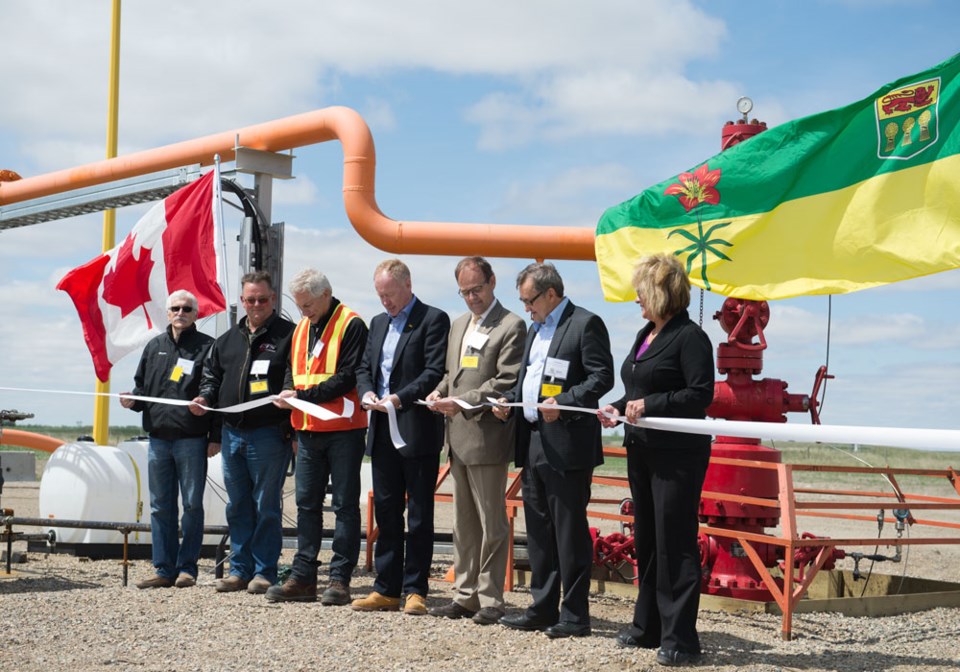
The storage component of Boundary Dam’s Carbon Capture and Storage (CCS) project, named Aquistore, received its official ribbon cutting ceremony on a breezy Friday afternoon at its research site near Boundary Dam (BD).
Eight months after the official opening of the retrofitted BD3 unit, the $45 million independent research project dubbed Aquistore was unveiled in its entirety through a series of site tours and demonstrations that was attended by politicians, engineers and students from the University of Regina.
"The results of the Aquistore project will be critical for the future and ongoing development of deep storage of CO2 around the globe," said Ken From, CEO of the Petroleum Technology Research Centre (PTRC) during the opening remarks.
The not-for-profit corporation researches technologies for the petroleum industry. Aquistore is one of PTRC's projects that will continue until 2017.
"PTRC is a centre point for the world-class research into the technical and geological aspects of safe storage of CO2," From said.
In an attempt to reduce Saskatchewan's greenhouse gas emissions, which according to Statistics Canada are the highest in Canada on a per capita basis, the Government of Saskatchewan is hoping the combination of BD3 and Aquistore will demonstrate that storing CO2 deep underground is a safe and workable solution to the problem.
So far, the technology is working, providing researchers with valuable information on the province's geological landscape, while potentially putting a dent in the province's high greenhouse gas emissions. The data on the project’s ultimate impact won't be available until GHG readings for 2014 and 2015 are analyzed.
About 1,000 tonnes of liquefied CO2 is injected to be permanently stored underground on a daily basis after it’s captured from BD3. This is a small portion of the overall captured CO2, the majority of which is sold to Cenovus for approximately $25 per tonne.
Saskatchewan's recently appointed minister of the environment Herb Cox scrummed with reporters after the opening ceremony and said the technology involved with Aquistore is "world class" and has piqued the interests of companies and technology enthusiasts from around the globe.
Cox also addressed remarks he made in the Legislature about climate change shortly after his appointment to environment minister, when he said he wanted to talk to his officials and "find out where we're at as far as the science goes."
Cox told reporters on Friday everyone should be concerned about climate change, a statement he said he repeated after his appointment.
"Admittedly, I may have been a little cautious with my next answers, but (the Government of Saskatchewan) is absolutely concerned about climate change and we think these kinds of projects will alleviate some (GHG emissions)."
Though the project is only in its early phases of operation, From told reporters the information they've been able to analyze so far is exciting.
"We have pressure confirmation when the CO2 is being injected, we can see the pressure response in the observation well, which is 150 m away," he said, adding it will be interesting to see the CO2's change in temperature as it moves further down the 3.4 km deep injection well.
A lot of the data the PTRC is looking forward to analyzing will occur once the CO2 reaches the observation well, which From noted, hasn't happened yet.
"The full analysis will take years," he added.
Souris-Moose Mountain MP Ed Komarnicki was at the Aquistore site to celebrate the official opening of the project and told reporters after opening remarks that no additional federal funding is being allocated towards Aquistore at this time. The federal government has already invested $14 million in Aquistore.
He addressed his upcoming retirement from politics, and said it would be nice to one day see other players in the oil industry tap into the captured CO2 and use it for their own enhanced oil recovery needs.
"I've always been of the view that there are many other junior oil players and other oil wells in the area and it would be very nice if there was some way to create a piping system that would allow others to tap into that system and use it for enhanced oil recovery in the area," he said.
Komarnicki said he understands a system of that complexity would take extensive planning and dedication on behalf of the parties involved, and added he believes it to be "doable."
Over the course of Aquistore's development, nearby landowners have been heavily involved in conversations regarding the project, and according to Dr. Ben Rostron, a professor of earth and atmospheric sciences at the University of Alberta and science and engineering committee member, they've been ensured that the process of injecting CO2 into the ground is safe.
"Everyone knows what's going on," he said. "We've had a very good response from landowners."
University of Regina students Jamie Kraushaar and Ying Piewkhaow attended the Aquistore ribbon cutting ceremony with much enthusiasm. The two are summer students working with the Ministry of Environment and were interested in the progress of carbon capture technology.
Piewkhaow has a PhD in engineering and is currently studying CCS technology. She said it is "extremely" important this technology is used and studied further.
"We have to capture the carbon somehow, because it will help with the environment," she said.



